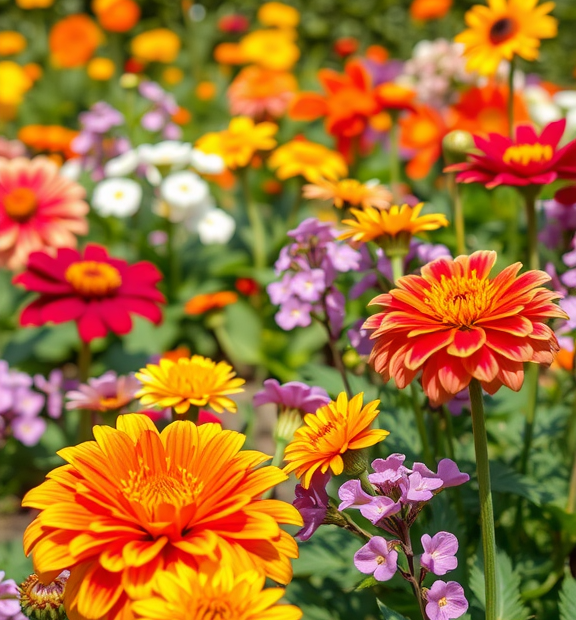Designing the Perfect Cut Flower Garden Layout for Optimal Bloom and Accessibility
Creating a cut flower garden is an enjoyable and rewarding endeavor. The right garden layout can enhance both the beauty of your flowers and your ability to easily tend to them. From selecting the right plants to arranging them for maximum visibility and accessibility, a thoughtful design brings joy to your gardening experience. Here are some essential strategies to design the perfect cut flower garden layout.
Start with a Plan
Before you dig a single hole, take the time to map out your garden. This initial planning phase allows you to visualize how different flower varieties will interact with each other. Consider the following steps:
- Choose a Location: Select a spot that gets at least 6-8 hours of sunlight daily. The soil should drain well to prevent root rot.
- Size it Right: Determine how much space you have. A small garden can be just as productive as a larger one when planned correctly.
- Think About Access: Ensure that your layout allows you to easily reach all parts of the garden for watering, weeding, and harvesting.
Selecting Flowers
The choice of flowers plays a crucial role in your cut flower garden layout. Some flowers bloom at different times, ensuring a steady supply. Choose a mix of annuals and perennials for variety. Here are some popular options:
- Annuals: Sunflowers, zinnias, and cosmos bloom all summer long and are excellent for cutting.
- Perennials: Peonies, coneflowers, and dahlias provide long-lasting beauty and can come back year after year.
- Foliage Plants: Include plants like ferns or hostas. Their leaves can add texture and interest to your arrangements.
Creating the Layout
Once you have selected your flowers, it’s time to create your garden layout. Organizing flowers effectively can improve air circulation and help prevent diseases.
- Layering: Arrange taller plants like sunflowers at the back of the garden bed and shorter flowers like marigolds at the front. This not only looks good but ensures that all plants receive adequate sunlight.
- Grouping: Place flowers of the same type in groups instead of scattering them. This technique makes a more impactful visual display and helps pollinators find them easily.
- Color Schemes: Consider a color palette that compliments your home and landscape. Use contrasting colors to make the blooms pop.
Accessibility Matters
Designing for accessibility is critical for maintaining your flower garden. Ensure that pathways are wide enough for easy movement. Here are some tips:
- Paths: Use mulch, gravel, or stepping stones to create clear paths between flower beds. This will make it easier to walk around without trampling plants.
- Raised Beds: If mobility is a concern, consider building raised beds. They reduce bending and make cutting flowers easier.
- Vertical Elements: Incorporate trellises or arbors with climbing flowers. They add beauty and maximize space.
Maintenance Tips
After your cut flower garden is blooming beautifully, regular maintenance is essential to keep it thriving. Follow these maintenance tips:
- Regular Watering: Ensure your flowers receive adequate water, especially during dry spells. Early morning is the best time to water.
- Deadheading: Remove wilted blooms to encourage further flowering and maintain a tidy appearance.
- Fertilization: Use a balanced fertilizer to feed your plants, encouraging robust growth and vibrant colors.
Designing the perfect cut flower garden layout involves careful planning, thoughtful selection of plants, and attention to accessibility. With these strategies in mind, you’ll be well on your way to cultivating a beautiful, productive garden that provides you with stunning bouquets throughout the growing season. Enjoy your gardening journey, and watch as your efforts blossom into a colorful display of nature’s beauty!
Seasonal Planting Strategies to Enhance Your Cut Flower Garden
Love what I do? Be a hero and help me keep creating awesome content!
Support My Mission Now!Every donation fuels more great stuff – thank you, legend!
Creating a stunning cut flower garden requires planning and a good understanding of seasonal planting strategies. These strategies not only help you maximize blooms throughout the year but also ensure that your garden thrives with minimal upkeep. Let’s explore some effective seasonal planting techniques.
Understanding Your Growing Zone
Before you dive into planting, it’s crucial to know your growing zone. The U.S. Department of Agriculture (USDA) divides the country into various zones based on climate. This knowledge helps you select plants that are well-suited for your environment. You can look up your zone online or check with a local gardening center.
Spring Planting Strategies
Love what I do? Be a hero and help me keep creating awesome content!
Support My Mission Now!Every donation fuels more great stuff – thank you, legend!
Spring is often considered the most rewarding season for planting. Here are some strategies to make the most of this season:
- Start with Hardy Annuals and Perennials: Early spring is ideal for planting hardy annuals such as pansies, snapdragons, and sweet peas. You can also include perennials like peonies and daylilies, which will become established and provide blooms for years to come.
- Use Succession Planting: This technique involves sowing seeds at intervals to ensure continuous blooms. For example, plant a row of zinnias every two weeks. This way, when one batch fades, another will be ready to take its place.
- Prepare the Soil: Healthier soil leads to better flowers. Amend your garden bed with compost or well-rotted manure before planting. Rich soil will feed your plants and enhance their growth.
Summer Planting Strategies
Summer heat can be intense, but it also provides an excellent opportunity for more blooms. Here are some summer-specific tips:
- Plant Heat-Tolerant Varieties: Select flowers like sunflowers, marigolds, and cosmos, which thrive in warm weather. These plants can offer vibrant colors and strong growth.
- Direct Sow Seeds: Many annual flowers can be sown directly into the ground during summer. Consider options like black-eyed Susans or cornflowers for late-season blooms.
- Consider Container Gardening: Containers can be moved around to catch the best sunlight. Fill them with colorful summer flowers such as dahlias and geraniums that will cheer up any space.
Fall Planting Strategies
Fall is not just for harvesting; it’s also perfect for planting certain types of flowers. Here’s how to make the most out of your fall planting:
- Plant Bulbs for Spring Blooms: Plant spring-flowering bulbs such as tulips, daffodils, and hyacinths in the fall. They need a cold period to bloom in spring, so now is the time to get them in the ground.
- Consider Late-Blooming Perennials: Incorporate fall-blooming perennials like asters and sedum to extend your flowering season. These will attract late-season pollinators and provide color when many gardens are fading.
- Improve Soil Quality: Take this time to clean up your flower beds and add compost to the soil. This enhances fertility and prepares your garden for the winter months.
Winter Planting Strategies
Love what I do? Be a hero and help me keep creating awesome content!
Support My Mission Now!Every donation fuels more great stuff – thank you, legend!
While winter may seem like a barren time for gardening, it’s an excellent opportunity for planning:
- Plan Your Layout: Use this time to sketch out your future flower garden. Consider which flowers you want to grow and how they will be arranged for year-round beauty.
- Order Seeds and Bulbs: Winter is the best time to browse catalogs and order seeds for the upcoming growing season. Having your supplies ready in advance sets you up for success.
- Start Seeds Indoors: If you have the space and light, start your seeds indoors to get a head start. Flowers like geraniums and tomatoes can benefit from this method, ready to be transplanted in spring.
By utilizing these seasonal planting strategies, you can create a healthy and vibrant cut flower garden that blooms beautifully all year round. With careful planning and the right flowers, your garden will become a stunning source of fresh cuts and instant beauty for your home. Happy gardening!
Conclusion
Love what I do? Be a hero and help me keep creating awesome content!
Support My Mission Now!Every donation fuels more great stuff – thank you, legend!
A well-planned cut flower garden layout not only enhances the beauty of your outdoor space but also makes it easier for you to enjoy the blooms you cultivate. By focusing on accessibility, you ensure that both maintaining the garden and harvesting your flowers are a delightful experience. pathways and proper spacing allows you to move freely among your plants, reducing the chance of damaging fragile stems or blooms.
Additionally, seasonal planting strategies play a crucial role in keeping your cut flower garden vibrant throughout the year. By selecting flowers that bloom in different seasons, you can create a continual display of colors and scents. Understanding the needs of each plant, such as sun exposure and water requirements, helps maximize their potential while minimizing maintenance efforts.
Embracing companion planting is another useful tactic to create a thriving ecosystem within your garden. Certain flower varieties not only coexist harmoniously but can also enhance each other’s growth. This thoughtful approach promotes a healthy garden, ensuring that your cut flowers bloom beautifully season after season.
Creating a cut flower garden is a rewarding journey, allowing you to express your creativity while providing spectacular blooms for arrangements, gifts, or simply to brighten your home. As you experiment with different layouts and seasonal strategies, each year will bring new joy and inspiration, solidifying your love for gardening. With a little planning and passion, your cut flower garden can become a haven of beauty, bursting with stunning flowers ready for any occasion.

